Virus or poisoned drinking water?
An Examination of the Tajik Poliomyelitis "Epidemic" (The Complete Study)
The official position regarding infantile paralysis (polio) epidemics is that they are caused by the polio virus. However, several scientists, who have provided plenty of evidence pointing in the direction of mass poisoning, are questioning this theory. In its own study the Nebáncsvirág Association examines the background of the 2010 "epidemic" in Tajikistan in the light of the above alternative explanation: is it possible that the disease was not caused by the virus but by industrial and agricultural contamination?
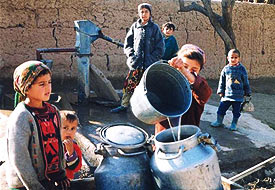
The 2010 Tajikistan Poliomyelitis "epidemic" caused a media stir, as Tajikistan belongs to the European Region of the World Health Organisation (WHO) which – supposedly owing to vaccinations – has been free of Poliomyelitis for almost a decade.
During the course of the year 579 cases of acute flaccid paralysis (AFP) were reported, most of which occurred between the end of March and early June. In three-quarters (457) of the cases, the presence of the polio virus was confirmed. Over half of these cases involved children under 5, with 29 fatalities. (CDC 2010, WHO 2011, TMB 2010)
WHO came to a disappointing conclusion when examining the vaccination history of the patients. Each of the eighty-seven patients with a traceable vaccination history received oral polio vaccination previously (Sabin vaccine). Seventy-six, that is, 87.35%, received three or more doses, and eleven (12.64%) received fewer than three doses. (WHO 23.6.2010)
Considering that a large proportion of the patients were children under 5, and therefore there could not have been a significant gap since their most recent vaccination, this proportion is of concern. Since they had undergone multiple immunisation, how could they have become paralysed?
Poliomyelitis (polio), that is infantile paralysis = an AFP, where polio virus is found in the patient's stool.
non-polio AFP = an AFP, where polio virus is not found in the patient's stool.
Is it certain that it is caused by a virus?
The media often proclaims that the polio virus is especially dangerous because "it multiplies in the intestines and spreads easily from man to man, especially in unhygienic conditions." (SIMONFALVI 2010) What they consistently fail to add is that it has been observed that Poliomyelitis patients are not required to be treated in isolation wards, because while they may pass on the alleged polio virus, they do not communicate the disease, that is the spastic symptoms. (SCOBEY 1951)
In most cases, polio contamination is completely symptom-free."Only 5% of the infected are affected by cold-like symptoms and diarrhoea (>illness<). Less than 1% of the infected produce the symptoms of muscle stiffness, muscle ache and paralysis (>major illness<), which does not subside in some of the patients, and which may lead to permanent paralysis and a lifetime of disability." (HIRTE 2005)
https://nebancs.hu/polio-gyermekbenulas/virus-or-poisoned-drinking-water/virus-or-poisoned-drinking-water-full.html#sigProGalleria00fe44ce5e
So how is polio diagnosed when there is so little connection between the infection and the appearance of symptoms? In the case of suspected polio (AFP), the patient's stool undergoes analysis in a laboratory. If the polio virus is found in the patient's stool, the disease is diagnosed as polio, if the virus is not present, the diagnosis is non-polio AFP. Whereas the symptoms and the course of the disease are identical in both cases, the stool composition suggests little connection with the nerve damage in the spinal cord. According to Ralph R Scobey, the virus attacks the already weakened cells, which means that its presence is not the cause, but the result of the nerve damage. (SCOBEY 1954) This, of course, is irrelevant from the patient's point of view, but not from the point of view of vaccination lobbyists.
The theory that Poliomyelitis is caused by the polio virus has a very flimsy basis. But if it is not the polio virus that causes Poliomyelitis, what does? According to Janine Roberts's revealing article (ROBERTS 2004), people's traditional observations and scientific experiments have shown for centuries that industrial and agricultural pollution might be behind the disease. This is further proven by the fact that in many cases improvement or full recovery of Poliomyelitis patients was achieved through the use of heavy metal extracting agents. (SCOBEY 1952)
Mass poisoning?
The official position regarding poliomyelitis is that it is caused by the polio virus. Polio infection causes intestinal or respiratory catarrh in only 5% of patients and only less than 1% of patients develop more serious symptoms, starting with meningitis-like symptoms followed by paralysis (mainly of the leg muscles closest to the trunk). (HIRTE 2005) If there are still live nerve cells left in the muscular fibre following their inflammation, these cells may regain their function and the paralytic state might improve. (Over 75% of Poliomyelitis patients recover without medical intervention. (HMS 2007)) However, if all the nerve cells die, the paralysis is irreversible, which may lead to serious deformations in the future. According to WHO, the established disease cannot be cured.
In Hungary, the first major Poliomyelitis "epidemic" took place in 1931. From the mid-1950s polio epidemics occurred more frequently and the disease was more serious. The last case of wild virus polio was registered in 1969. (The last "AFP" epidemic occurred in 1978, but it was linked to enterovirus 71, and not to the polio virus. (MARX ET AL 2000) AFP, however, does occur in Hungary to this day, 10 cases a year, on average.)
In Hungary, the vaccination against Poliomyelitis started in 1957, using the Salk vaccine. It was found that this vaccine contained a great deal of contamination and did not prevent epidemics and so two years later they switched to the Sabin vaccine. (ROBERTS 2004) Since Sabin drops contain live viruses, they may maintain virus circulation, and in accordance with new WHO guidelines, "improved efficacy" Salk vaccines have been used since 2006. This is included in the mandatory "Di-Per-Te-IPV-Hib" combined vaccination administered at 2, 3, 4, and 18 months. The abbreviation IPV (inactivated polio virus) represents the component against Poliomyelitis. (GYŐRI 2011)
WHO declared the European Region polio-free in 2002, and claimed that this was due to polio vaccination. In 2010, however, a new "epidemic" broke out in Tajikistan.
In her series of articles entitled "Polio: the Virus and the Vaccine", published in The Ecologist in May 2004, Janine Roberts claims that this polio is not caused by an infection virus, but is a mass poisoning, caused by chemicals and various metals used in industry and agriculture. In her articles, she most frequently quotes from the scientific work of Poliomyelitis researcher Ralph R Scobey. Scobey first raised the possibility in the 1950s that the illness might not necessarily be caused by the virus, and the virus might only be attacking already weakened tissues damaged by something else. He was the first to come to the position that Poliomyelitis may actually be poisoning.
The following facts point against the theory of viral infection:
- Only 1%-a of those infected by the polio virus suffer from the symptoms of Poliomyelitis.
- The polio virus cannot be detected in a number of cases of AFP, even though the pathography is identical to that of Poliomyelitis.
- The polio virus could rarely be detected in blood samples, and it has never been multiplying in the motor nerve cells of the spinal cord, even though these are damaged during Poliomyelitis. The pathogen is searched for in stool samples, and a diagnosis is set up on the basis of that.
- A strange contradiction is mentioned in scientific literature: "In inadequate hygienic conditions the infection may be spread by objects soiled with excrement, and, in rare cases, by infected drinking water and food - primarily milk. Paradoxically, without vaccination, the number of diseased is higher in the segments of the population who live in better social circumstances, and thereby in better hygienic conditions." (DÉSI 1995)
- Specialist literature claims that Poliomyelitis existed in ancient Egypt, but the only basis for this are a few mummies with shorter legs and an artistic representation, which may only suggest that there were some isolated cases. The first known epidemic broke out in Italy in 1883. (BECKER 2011) How is it possible, that we have no knowledge of previous epidemics, when medical science was capable of giving the exact medical description of serious illnesses and of identifying the characteristics of epidemics centuries ago?
The evidence supporting the possibility of mass poisoning includes the following:
- Poisoning from pesticides and certain metals might actually lead to paralysis.
- Epidemics broke out in places and at times where and when serious neurotoxins had been used, for example the infamous DDT.
- Before the discovery of the first persistent pesticide in 1874, there were no known poliomyelitis "epidemics", only isolated cases.
- Strangely, before heavily toxic pesticides were banned, epidemics always occurred during the summer, when children consumed fresh fruit which had been treated with pesticides.
- Hungary was the first in the world to ban DDT in 1968, and the last wild virus case of Poliomyelitis was registered there in the following year.
- In many cases, the condition of paralysed patients was improved by the use of toxic heavy metal expedients, such as ascorbic acid, thiamine, methylene blue, iodine, and dimercaprol.
About industrial and agricultural pollution
From ancient times to the beginning of the 20th century, Poliomyelitis was attributed to heavy metal poisoning, on the basis of the illness's symptoms and physiological effects. The fact that lead may cause paralysis was discovered in 200 B.C. (MONROE 2011). British scientist John Cooke, wrote in 1824 that certain "metals cause paralysis by their evaporation or if their solutions are consumed." In 1878, Alfred Vulpian proved through experiments that lead poisoning causes the same damage in the motor nerve cells of dogs, as is caused in human victims of poliomyelitis. The Russian Popov made a similar discovery about arsenic in 1883. Consequently, a number of experiments proved that certain metals – primarily lead, tin, arsenic, aluminium, and mercury – cause poliomyelitis-like symptoms when they are accumulated in the body. These symptoms include diarrhoea, ailment of the cerebrum (for example, in the case of aluminium), general muscle paralysis, but primarily paralysis of the legs, and respiratory arrest. (NORDBERG 2007, HRS 1996)
The repository of materials causing paralysis expanded in the 20th century through the discovery and widespread use of pesticides.
Acute (one-off, high dose) pesticide poisoning might also lead to paralysis. This is not surprising if we bear in mind that some pesticides contain arsenic and mercury. The symptoms emerge soon after coming into contact with the pesticide, but no later than four weeks after the contact. The symptoms might be cramps in the lower limbs, which may lead to uncoordinated movement and paralysis. This condition might improve after some months or years, but the damage might also be permanent. A very high dose may result in unconsciousness, cramps and death. (EJF-PANUK 2007)
Pesticides which inhibit the acetyl-cholinesterase enzyme are especially dangerous to human health. This enzyme is essential for the adequate function of the nervous systems in both humans and insects. These chemicals include organophosphates and carbamates, for example aldicarb, paration (both are "highly dangerous" according to WHO ratings) and metamidophos ("extremely dangerous"), which are amongst the 10 most widely used pesticides in cotton plantations worldwide. (This is an important piece of information from the point of view of Tajikistan.) As a result of these, the nerve cells cease to communicate with each other, neural coordination is damaged and the following symptoms occur: shaking, nausea, weakness, or even paralysis and death. Acetyl-cholinesterase inhibitor pesticides have also been related to neurological damage in babies and foetuses, with chronic fatigue syndrome (CFS), and with Parkinson's disease. (EJF-PANUK 2007)
Regarding DDT specifically, according to Dresden's research DDT poisoning and poliomyelitis are very similar physiologically: like poliomyelitis, DDT causes visible changes in the tissue of the central nervous system, mainly in the cerebellum (the centre for the coordination of movement), and in the spinal cord (where nerve cells responsible for movement are found). (WEST 2002)
These toxins generically pose a higher risk to children because of their smaller body size, different metabolism, their fast growing, developing organs, and because of their rudimentary blood-brain barrier. This might explain why most victims of polio "epidemics" are children under 5. (EJF-PANUK 2007)
Poisons in agricultural areas
Is it possible that a poisoning caused by heavy metals or pesticides occurred in the areas of Tajikistan struck by the "epidemic"?
Comparing the map indicating the occurrences of poliomyelitis to the map indicating population density clearly shows that the highest number of cases occurred in the most densely populated areas. The area around the town of Kurganteppa, or rather the Bokhtar region, spreading over the Southern, agricultural area stands out as one of the most badly affected areas. Kurganteppa, with a population of 80-85 thousand, is the third largest city in the country, after the capital, and is the centre of Tajik cotton production.
Cotton is grown in a third of Tajikistan's agricultural areas. It is primarily grown by poor people in the country on small pieces of land that cover merely over an acre. Only recently, on one occasion an average of a pound of dangerous pesticides were used on a piece of land this size.
Even though Tajikistan signed up to the Rotterdam Agreement in 1998, it is yet to ratify it, so none of the ten most dangerous pesticides used for cotton are banned in the country. These include the substances mentioned above, which inhibit the enzyme acetyl-cholinesterase: aldicarb, paration and metamidophos. (Only one drop of aldicarb can kill an adult.) (EJF-PANUK 2007, UNEP 2008)
https://nebancs.hu/polio-gyermekbenulas/virus-or-poisoned-drinking-water/virus-or-poisoned-drinking-water-full.html#sigProGalleriad47e358c71
DDT is not the only pesticide banned by WHO out of the over 80 kinds of available substances. (To be precise, WHO only allows the use of DDT in special cases as a preventive measure against malaria mosquitoes.) Aldrin, dieldrin, endrin, heptachlor, and toxaphene are also in use. (UNEP 2007) These materials take a very long time to decompose (39% of the originally used dieldrin was shown to be still in the soil after 17 years), furthermore, they accumulate in living organisms, which means that predators on the top of the food chain may be shown to carry many million times the original concentration (this phenomenon is called biomagnification). (DARVAS 2000) The pesticide market also offers hexachlorobenzene ("Highly dangerous" according to WHO), and chlordane ("moderately dangerous", like DDT), as well as organic phosphorus, and chemicals containing mercury. (UNEP 2007, WHO 2004)
Before the "epidemic" of 2010 the last poliomyelitis in Tajikistan was registered in 1997 and the last "epidemic" occured in 1991.
A further problem is caused by the fact that while in Soviet times the import and the distribution of pesticides happened centrally, today it is in the hands of private enterprises and uninformed people. (UNEP 2010) The labelling on pesticide containers often does not carry much information or is simply forged, and therefore the producers are unaware of what they are buying, so they might be using chemicals recommended for a different crop than their own or under different weather conditions. (BCI-EBRD 2008) The quality of pesticides is also unsatisfactory. A further risk is posed by some of the users being illiterate or uninformed about the potential dangers of pesticides and using the chemicals without protective gear.
The example of a chemical called "Dust", primarily sold in markets by women and children, is a good illustration of the problems with quality. According to laboratory tests, this contains 26 to 30% DDT. The other component could not be identified with the devices available. This mixture is sold in conventional sacks by the kilo. (UNEP 2010)
The town of Kurganteppa lies on the Vakhsh River, which irrigates a large area of Tajik agricultural land. The drainage from irrigation flows back into the river, carrying salts and artificial fertilisers, as well as the pesticides described above. The Vakhsh River has the highest pesticide concentration today. According to 2004 data, the concentration is up to 48 kilograms per hectare. (UN 2004). Furthermore, the river is also polluted by industry, including manufacturers of artificial fertilizer and chemicals. (UN 2004)
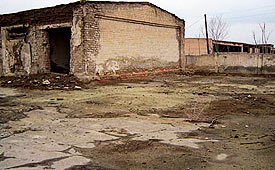
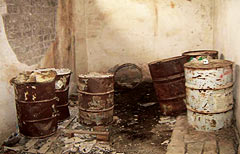 |
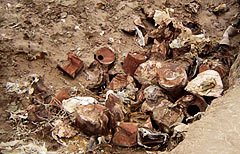 |
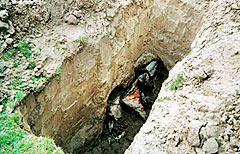 |
The main source of the pollution was likely the largest pesticide manufacturer of the country, located in the Vakhsk Valley, South-West of Kurganteppa, 30 kilometres from the town of Vakhsh. Between 1973 and 1991, about 7,500 tons of expired or withdrawn pesticides were buried in this 30 acre area. (Including 3000 tons of DDT.) The locals often dig up these pesticides for agricultural use, or for selling them on. The dug up, useless containers, which are considered hazardous waste, are scattered around. The refuse dump is unmarked, it is not enclosed, it is washed by rain and windblown, which means that nothing stops the waste from polluting the soil and the air. There is an irrigation canal just 17 kilometres from the refuse dump. (UNEP 2007) A smaller, but similarly hazardous pesticide cemetery can be found in the North of Tajikistan, five kilometres from the town of Kanibadam. This site contains 4,000 tons of hazardous pesticides buried in the ground. If we went by the figures published in 2000 by the Asian Development Bank, there are "only" 2.5 thousand tons of hazardous chemicals in the two waste disposal sites; this would mean that for the best part of the last four decades 9.5 thousand tons were dug out and taken. (ADB 2000).
Pesticide storage facilities pose a similar risk. There are 169 such facilities known nationwide. Many of these are derelict, and many are located next to settlements, sources of drinking water, or agricultural land. These facilities are not enclosed, they are not guarded, and often even the roof, doors or windows are missing, because they were used in other building projects. This means that both people and animals are free to enter. Sometimes building materials and household utensils are stored next to the pesticide containers, and sometimes the storage facility is used for residence. (UNEP 2007) Rainwater trickling from the direction of these facilities often kills cattle by poisoning them. (UNEP 2010)
Another important issue is the way the quality of these chemicals changes during storage. The pesticide called malation is said to become more toxic with the passage of time, especially in high temperatures. The prospects of the metal containers left in the baking sun of Tajikistan's Sub-Tropical climate are less than promising. (SINCLAIR 2011)
The main polluters of surface and underground waters (ADB 2000, ADB 2001)
| Basin and Polluter | Potential Contaminants |
|---|---|
| Kafernigan Basin | |
| Wastewater treatment facilities (Shartuz, Gissar, Dushanbe, Kofarnikhon raion) and poultry plant | E. coli, heavy metals, nutrients |
| Cattle and dairy plant in Kabodion raion | Nutrients, possibly disease (leptospirosis) |
| Cement plant in Dushanbe | Alkaline effluents |
| Takob smelter | Heavy metals (zinc, lead) |
| Agricultural runoff | High mineral content, potential agrochemical contaminants |
| Vakhsh Basin | |
| Wastewater treatment facilities (Kurganteppa, Jomi, Nurek) | E. coli, nutrients, heavy metals |
| Vakhsh nitrogen fertilizer plant | Nitrogen compounds |
| Cattle and dairy plant (Jomi) | Nutrients, possibly disease (leptospirosis) |
| Yavan chemical plant | Not available |
| Central wastewater collector drain | Nutrients and minerals, possibly agrochemical contaminants |
| Zeravshan Basin | |
| Anzob gold processing plant | Mercury, sulfates, antimony |
| Syrdarya Basin | |
| Wastewater treatment plants (Kairakum, Khujand) | E. coli, nutrients, heavy metals |
| Food processing plants (Kanibadam, Isfara, Proletarsk, Gafurov) | Nutrients, e. coli (meat processing) |
| Chemical plant in Isfara | Not available |
| Metallurgical plant in Isfara | Heavy metals |
| Adrasman plant | Heavy metals (lead, zinc, cadmium) |
| Furniture factory (Khujand) | solvents |
| Porcelain factory (Khujand) | Not available |
| Khujand mine | Tungsten, molyibdenum, cobalt, nickel |
Poisoning in the industrial area
On the map showing the geographical dissemination of polio cases, Tursunzade, Shahalnav and Lenin counties display a remarkably high concentration of the disease, which might be a result of poisoning caused by industrial activity.
Tajikistan's most significant industry is mining. There is very little information available on mines. There are around 70 of them, and according to data from 2000, they produce 77% of the country's solid waste. (ADB 2000) Ore processing produces a large amount of sludge, and there is also sludge left over from the old ways of handling industrial waste water. This contains mercury, antimony, aluminium and lead (each of which may cause paralysis). The sludge is stored in tailings which do not comply with international environmental regulations. (UNEP 2004) Therefore, most waste from mining remains untreated, and as such, it endangers the purity of air, soil, underground, and in some cases surface waters.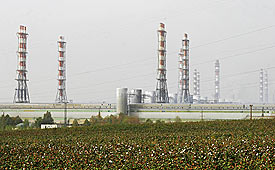 Amongst other things, gold, arsenic, antimony, mercury, sulphides, zinc, and lead are mined. However, aluminium processing is the most profitable industry, which uses imported bauxite. (Out of these, arsenic, mercury, and aluminium were stated to cause symptoms similar to polio.)
Amongst other things, gold, arsenic, antimony, mercury, sulphides, zinc, and lead are mined. However, aluminium processing is the most profitable industry, which uses imported bauxite. (Out of these, arsenic, mercury, and aluminium were stated to cause symptoms similar to polio.)
The Tursunzade aluminium processing plant is the largest aluminium producing plant in Central-Asia, and perhaps in the world. The plant causes continuous fluorine contamination in its surrounding area, which gives rise to brittle bones, teeth and gum diseases, and dermatological disorders.
The centre of mercury and antimony mining in Tajikistan is Anzob, where millions of tons of waste were accumulated (containing mercury, antimony, arsenic, and lead), which sometimes got into the Yaghnob River. In the Northern town of Khujand, there is significant mining of arsenic, lead, and other materials.
However, Anzob and Khujand lay outside the geographical centres of the 2010 polio "epidemic". Unlike the Takob foundry, which lies North of the capital, and lets zinc and lead into the Varzob River. (ADB 2000) The Varzob River, contaminated with industrial and domestic waste water, slices through Dushanbe, the capital, before it enters the Kafirnigan River, which touches the Uzbek border and flows into agricultural areas. The river carries domestic sewage, and here it becomes further contaminated with pesticides and artificial fertilisers before it flows into the Amudarya River on Tajikistan's southern border. Despite being so polluted, Kafirnigan serves as a source of drinking water for the population in the surrounding areas. Sewage cleaning plants are only available in certain towns, but even these work to a substandard level, only making matters worse. (UNEP 2002)
Unenclosed, unguarded, urban refuse dumps also contain some hazardous waste, toxins from which are washed out by rain into surface waters. So these need to be included here.
Since the recycling of mercury remains unresolved, over six hundred thousand strip lights containing mercury vapours end up in ordinary rubbish dumps. Expired strip lights should be deposited on the companies' own sites, but they are running out of space, so they are trying to set up illegal dumps. The collection and removal of household strip lights is unresolved, so these often end up in rubbish dumps in the cities.
The problems posed by these mercury lights are so significant that in its 2000 study, the Asian Development Bank considers them the most hazardous toxic waste in Tajikistan. (ADB 2000)
Classification of refuse based on toxicity (ADB 2000)
| Class | Area Occupied | Type of waste stored |
|---|---|---|
| Extremely dangerous | Special storage facilities on enterprise and factory grounds | Example: mercury lamps (600,000) |
| Highly dangerous | 14 hectares (ha) at Vakhsh and Kanibadam landfills | Example: toxic chemicals (2.5 thousand tons) |
| Moderately dangerous | On the grounds of plants and enterprises | Example: slag from galvanizing process; 1.72 million tons of radioactive waste |
| Slightly dangerous | 800 ha (22 tailings) | Example: 190 million tons of mining waste; 20 million tons of slurry |
| Total | 1,100 ha | 210 million tons |
Direct cause
So what happened in Tajikistan in the spring of 2010?
The year 2010 posed particularly great difficulties to the Tajik population. The heavy rainfalls, which started at the end of March and lasted 2 months, led to serious floods, mudslides and landslides in 21 regions. This was the worst natural disaster the area had suffered for over a decade. According to official data, 40 people lost their lives, 33 disappeared, and 300 were injured. (The people estimate a much higher number of deaths). Roads became impassible, bridges collapsed, herds of cattle perished, water pipes were damaged, the food reserve and the sowing seeds were destroyed, and about 5,000 acres of agricultural land were flooded. And the possible cause of the "epidemic": about 70 thousand people remained without safe drinking water. (REACT 19.5.2010)
https://nebancs.hu/polio-gyermekbenulas/virus-or-poisoned-drinking-water/virus-or-poisoned-drinking-water-full.html#sigProGalleria3c4df1d706
In Kulob, which is Tajikistan's fourth largest city, 4,500 people were left without a roof over their heads, and the repeated floods plunged 16 thousand people into deep poverty. Their produce was washed away, their livestock perished, and grazing land was covered by mud and stones. As a result of the heaviest rainfall on 7 May, 510 metres of water pipes were destroyed, which caused a serious lack of drinking water for the city's 100 thousand inhabitants. The locals complained about the sluggishness and unpreparedness of the disaster relief effort, as they had not received any food, dry clothes, or medicine two days after the flooding. (RFE/RL 2010) No information is available as to where they sourced drinking from, but it is likely that they tried to depose of contamination in the river water by letting it stand. This seems to be the standard method from a short Oxfam film ("Bitter Sweet Water").
Let us quote the UN's 2004 environment study on Tajikistan: "Heavy metals and uranium settle in the sludge in the riverbeds. During heavy rains and flooding, these are disturbed and lead to contamination of the rivers."(UNEP 2004)
On 25 May, a humanitarian news website called ReliefWeb reported that the city of Kulob was on the verge of an epidemiological crisis. The repair of the water pipes had started, but they lacked the means for full reconstruction. Three weeks later, according to a report from 16 June, drinking water was safe in Kulob. They also report that there had been a spectacular drop in the number of AFP cases. (REACT 25.5.2010.)
Regarding the temporal correlation between the drinking water crisis and the polio cases, the number of polio cases suddenly increased on a national level at the end of March, at the start of the rainfalls. The polio cases peaked in the middle of May, and after the weather normalised at the end of May, the number of new cases of paralysis fell back to normal.
With regard to locations, by comparing the map of the heavy rainfalls and the epidemiological map, a significant overlap can be seen. The centres of the epidemic are the more densely populated areas and the counties lying by the polluted rivers. (In order to see the connections, it is important to bear in mind that the epidemiological map only marks the number of cases which occurred within each county, and the dots are placed randomly within the boundaries of the given county.)
Safe drinking water?
Firstly, it should be noted that Tajikistan is the poorest of all the successor states of the Soviet Union, and it is amongst the 20 poorest countries in the world. 80% of the population lives on less than $10 a month, and acute malnutrition affects 8 to 10% of the population. (IRIN 2003)
What Tajikistan is one of the richest countries in, is natural water, thanks to its abounding rivers, and the glaciers feeding most of these. Despite this, it is the most difficult to source safe drinking water in Tajikistan among the countries of Central Asia. According to data from 2005, only 59% of the population drinks clean water.Diseases, spread by polluted drinking water, pose a serious danger to the population. Typhus, dysentery, intestinal infections, and hepatitis are common, and this contributes to the preservation and deepening of rural poverty. Almost a quarter of the water supply system is out of order, half of it does not comply with standards of hygiene, and because of blackouts, they generally operate periodically with constant shut-downs (in the winter period only for 2 hours a day), which means that practically nowhere can guarantee safe drinking water permanently. (ADB 2004)
https://nebancs.hu/polio-gyermekbenulas/virus-or-poisoned-drinking-water/virus-or-poisoned-drinking-water-full.html#sigProGalleria99bce78fc3
The serious water conservation problems started in 1991 following Tajikistan's leaving the Soviet Union. In Soviet times, most villages had piped water, which was managed by an administrator from the collective, or an expert. Today only 20% of these operate, because of the vacuum in local government, which has followed the break-up of collectives, and as a result of non-maintenance and damages caused in the drawn-out civil war (1992-1997). Having lost these systems, rural residents have been forced to seek their own drinking water. They began delivering drinking water by trucks to certain villages. However, those who cannot afford this, resort to using the water from shallow hand-dug wells, small lakes, springs, and rivers. (ADB 2004, UNEP 2004)
Even in the piped water system, the water is of bad quality, highly polluted, and 40% of it poses a risk of epidemic. (Biological water treatment is only available in the capital city of Dushanbe.) According to WHO, up to 60% of intestinal infections in Tajikistan are spread by water.
Because of gaps and leakages in the system, contaminants from the soil get into the water. Nitrates, sulphates, chlorides, heavy metals, and various bacteria. An inspection of 5987 water samples for chemical contamination showed that only 3002 (50,1%) met requirements. (UNEP 2004)
Lead poisoning from the Takob foundry
https://nebancs.hu/polio-gyermekbenulas/virus-or-poisoned-drinking-water/virus-or-poisoned-drinking-water-full.html#sigProGalleria825a46c54f
This supposition is confirmed by the fact that the following AFP symptoms are stated in the above mentioned report: diarrhoea (in at least 20% of patients), limb paralysis only (95%), limb and respiratory paralysis (4%), limb and facial nerve paralysis (1%), facial nerve paralysis only (1%).
Lead poisoning may cause paralysis and brain disease (the latter is also another characteristic of polio). Another general symptom is diarrhoea and, in severe cases, limb paralysis (which mainly effects the arms and wrists). Respiratory paralysis (BEATTIE ET AL 1975, MEJA 2008) and facial nerve paralysis (WARREN 2001) have also been reported in connection with lead poisoning. There is a large scale of possible symptoms. According to a textbook: "There is no other poisonous substance that causes such high variation of symptoms as lead. Therefore, experts set up a rule whereby in all cases of lead poisoning diagnosis, the patient's occupation must be taken into account; that is, if the patient works with lead, symptoms that would otherwise be considered normal, must be taken seriously, because they might show the onset of lead poisoning." (SCHNEIDER 2008) Children living along the Varzob and the Kafirnigan rivers fell victim to this intangible definition, as they were not at risk of occupational hazard.
Since the polio virus was found in some of the cases, it is likely that the possibility of lead poisoning never arose. However, all of the reported symptoms could suggest lead poisoning.
Comparing the flood maps and the epidemiological maps makes it highly likely that the April cases were caused by the Takob foundry's pollution of the river.
Interestingly, the map shows that in areas of flooding where pollution was not as significant, the number of "polio" cases was infinitesimal. This is most surprising in the Kulob area, as this was the region worst affected by the heavy rainfalls. it is a relatively densely populated area (Kulob is the fourth largest city in Tajikistan), and also the poorest. Despite all of the above, not only the April map, but the summary map, also shows a relatively small number of cases.
Unexplained facial nerve paralysis and AFP
Interestingly, there was facial nerve paralysis amongst the symptoms. According to the definition of poliomyelitis, it is characterised by limb paralysis and respiratory paralysis only. If the paralysis is only in the face, it does not count as an AFP, and does not have to be reported. (CDC 1998)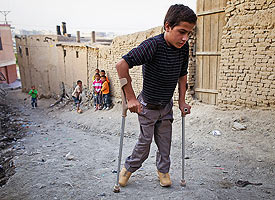 The American Health Authority, the CDC, complains in a 1998 report, that by reporting facial nerve paralysis, certain countries cause inaccuracy in the observational statistics, and it admitted that facial nerve paralysis appears in a surprisingly high percentage beside the AFP cases. CDC does not attempt to give an explanation, and instead of collecting data and carrying out inspections, it suspects that these cases of facial nerve paralysis might be explained by the bacterium which causes Lyme disease. (CDC 1998) This, however, is not a possibility in the case of Tajikistan, as they have never registered any cases of Lyme disease in the country throughout history. (HIGGINS 2004)
The American Health Authority, the CDC, complains in a 1998 report, that by reporting facial nerve paralysis, certain countries cause inaccuracy in the observational statistics, and it admitted that facial nerve paralysis appears in a surprisingly high percentage beside the AFP cases. CDC does not attempt to give an explanation, and instead of collecting data and carrying out inspections, it suspects that these cases of facial nerve paralysis might be explained by the bacterium which causes Lyme disease. (CDC 1998) This, however, is not a possibility in the case of Tajikistan, as they have never registered any cases of Lyme disease in the country throughout history. (HIGGINS 2004)
Not only Lyme disease, but, amongst other things, a brain tumour or a stroke might also cause facial nerve paralysis. The possibility of metal poisoning is lesser known, (e.g., in the cases of mercury, arsenic, and lead, but cases of aluminium poisoning (GU 2000)), and even organophosphate poisoning, have also been known (VICTOR 1978). If no causes are found behind the facial nerve paralysis, the diagnosis is Bell's palsy. Sufferers of this disease often report a metallic taste in the mouth, on the paralysed side. (Usually hemiparesis occurs in the face.) In over two-thirds of the cases this kind of paralysis disappears without treatment, often within three weeks, but at most within a year. (PEITERSEN 1982) This observation shows a great similarity to polio, which in most cases gets better without treatment. (Less then 25% of polio patients remain disabled for the rest of their lives.) (HMS 2007)
The total number of cases of facial nerve paralysis in the Tajik "epidemic" are not known, as they "do not have to be reported". It is still telling that while according to WHO's February 2011 report there were 712 cases of AFP in Tajikistan in the previous year, (WHO 7.2.2011), their most recent data puts the final number at 579 (WHO 1.1.2012). This means that in the end 133 cases were not considered AFP. It is likely that this was because these were cases of facial nerve paralysis "only". If this is true, 19% of all cases of paralysis were that of the facial muscle.
The removal of the obligation to report cases of facial nerve paralysis is most surprising in the light of a study by John Hopkins University, which states that facial nerve paralysis may be caused by the polio virus (and it may also be one of the symptoms of the Guillain-Barré syndrome). (MARX ET AL 2000) The attitude of the health authorities is also surprising, as they will not release information on what might have caused the facial nerve paralysis, since Lyme disease is out of the question.
Meanwhile, no information is available as to the nature of the non-polio AFP cases. The final diagnosis of the patients whose stool samples did not contain the polio virus is also unknown. How many patients suffered from Guillain Barré syndrome, how many from meningitis, how many from myelitis, etc.? This data cannot be found with regard to polio epidemics in other countries, at different times, either. The only data we found was from Nepal, according to which there were around 200 cases of AFP a year between 2001 and 2006, out of which the polio virus was only present in 0 to 4 cases. 19 to 32% of the cases were caused by other enteroviruses, and the remaining 68 to 81%, the vast majority of cases, were not mentioned at all (WHO 2006). These cases would make an interesting study, as even according to the official line, a proportion of AFPs are caused by poisoning: e.g. organophosphates (pesticides such as malation and paration), and metals (arsenic, thallium, gold, and lead). (UWO 2003) It would be highly illuminating to learn how many AFPs like this were diagnosed in Tajikistan.
Altogether, the whole AFP matter is so intricate, and the different types of AFP show so many misleading similarities, that doctors must have a difficult time setting up a definite, indubitable diagnosis.
And this raises the question: how reliable are diagnoses? Are all possibilities, including organophosphate and metal poisoning, investigated in all patients? Or does the investigation start at enteroviruses, and where they are found no further investigations are carried out (thereby never ascetaining if the concentration of certain toxins in the patient's blood exceeds the normal limit)? On the basis of medical protocols, this seems to be the case. (BENTSI-ENCHILL 1997) In practically all cases of AFP, the polio virus is investigated. If it is not found in the stool, the blood is investigated for traces of recent polio infection. If there are no traces of the polio virus, medical experts focus on other enteroviruses, following which the medical protocol seems to cease. It is possible to investigate further, but since, on the basis of a table published by the Johns Hopkins University, there are 28 possible causes of AFP, which makes it very unlikely that all eventualities will be looked into. Admittedly, "the clinical investigations into AFPs are often restrained by the available medical infrastructure and the available resources." (MARX ET AL 2000)
It is no surprise therefore, that a small proportion of AFPs will "become" polio or other enterovirus infections (depending on what is found), and the rest (over half of all AFP cases) are given the diagnosis of Guillain-Barré syndrome (the causes of which are unknown, and the definition of which is fairly loose).
Arguments and counter arguments
A summary of events on the basis of the data found during our research: In March to May 2010, heavy rainfalls led to floods in Tajikistan. These caused metals and pesticide residues to run into natural waters from agricultural land; unenclosed, uninsulated pesticide disposal sites; industrial sludge reservoirs and storage facilities; and from refuse dumps. In disaster areas, the lack of safe drinking water forced the population to use these water sources. As a result of this, at the start of the rainfalls the number of polio cases increased in the areas where river water was the most full of toxins, while it dropped again after water supply systems had been restored, and the intensity of the rainfalls decreased.
https://nebancs.hu/polio-gyermekbenulas/virus-or-poisoned-drinking-water/virus-or-poisoned-drinking-water-full.html#sigProGalleriaf5113bf205
Supporters of the "virus theory" would agree that the diseases were caused by the drinking water crisis, but their argument would be that waste water containing polio infected stool entered the drinking water during the floods, the consumption of which had caused the epidemic. It is a fact that waste water pipes often run next to drinking water pipes, so when they get damaged, the mixing of the waters is practically unavoidable. (UNEP 2004) According to textbooks, the polio virus is spread mainly through drinking water and food contaminated by excrement. The water could have been contaminated by enteroviruses leading to paralysis other than polio. One of these is the Coxsackie virus, which is another reason supporters of the "virus theory" give for a sharp increase in the occurrences of non-polio AFP. However, it should be noted that most cases of the Coxsackie virus infection, similarly to polio, are symptomless, which provides further ground for questioning the virus theory.
Another question is where the polio virus came from so suddenly. For 13 years it had not been found in the stools of any Tajik AFP patients, even though, theoretically, laboratory tests are carried out in all cases. Genetic tests show that polio is likely to have originated in India, where mass infections of poliomyelitis occur frequently, that is India is endemic. The Tajik pathogen shows the closest resemblance to the wild virus found in India.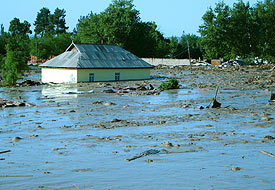 Therefore, according to supporters of the virus theory, one or more virus carriers from India could have been the origins of the "epidemic", the spreading of which was helped by the fact that people in the disaster-struck regions were forced to consume contaminated water. But is it possible for a virus, which is spread by excrement-contaminated water, to cause infections in such a large area in such a short time period?
Therefore, according to supporters of the virus theory, one or more virus carriers from India could have been the origins of the "epidemic", the spreading of which was helped by the fact that people in the disaster-struck regions were forced to consume contaminated water. But is it possible for a virus, which is spread by excrement-contaminated water, to cause infections in such a large area in such a short time period?
Furthermore, how is it possible that in places where toxins are negligible, the polio virus failed to spread despite flooding and an inadequate drinking water supply? In Rasht (Gharm) county, only one case of polio was reported, and hardly any in the counties (Darband, Roghun, Fayzobod, Nurek) further down the Surkhob River, which flows through Rasht, or down the Vakhsh River. Moreover, as we reach the industrial areas (Nurek reservoir), only the number of AFP cases increase, not those of polio. How is it that there was no mass infection of polio here? These areas were also flooded and the population density is not smaller at lower sections of the rivers than in the areas highly infected by polio.
Would it not be logical to consider that all cases of paralysis might have been caused by industrial and agricultural pollution, and that the presence or non presence of viruses are irrelevant?
In order to discard this alternative explanation completely and beyond doubt, a systematic investigation should be carried out as to whether the possibility of mass poisoning could be excluded, and as to why only 6% of those infected with polio do get ill.
We have no knowledge of any reliable investigations carried out by WHO or another organisation which could settle this debate. (1) What is the pesticide residue and heavy metal content in the AFP patients' blood and tissues, and by comparison that of healthy people's samples? (2) In both cases, what viruses related to paralysis are found in their stool?
As long as no such investigation is carried out, WHO and other health authorities are acting in an unscientific manner when they disregard the arguments of Scobey and others without giving a reasonable explanation, as they have done for half a century. Moreover, they act irresponsibly towards millions of people, since they stop sick children from learning that heavy metal extracting agents might help recovery; they also make ethically disputable recommendations to the governments of developing countries, so that they burden their limited budgets through the purchase of ineffective vaccines.
Why do we vaccinate against poliomyelitis?
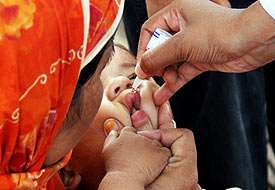 As we have seen above, all of the Tajik polio patients with a traceable vaccination history had been given the polio vaccine, and 90% of them received three or more polio vaccinations. Still, most of these patients were children under 5. This means that the vaccination failed to protect them from the disease.
As we have seen above, all of the Tajik polio patients with a traceable vaccination history had been given the polio vaccine, and 90% of them received three or more polio vaccinations. Still, most of these patients were children under 5. This means that the vaccination failed to protect them from the disease.
Official bodies are confounded by this data, since according to the Tajik Ministry of Health, the population's vaccination was higher than the required level. They explain themselves by the use of complicated sentences like this: "Due to a decrease in sanitation and access to clean water in the southwestern regions with heavy continued flooding, environmental exposure to vectors of polio may have increased the incidence of Poliomyelitis beyond the expected levels." (HASANOVA 2010)
That is, one can never be vaccinated enough.
The WHO were certainly surprised, since the following sentence appears in their June 2010 report: "Investigation was under way to confirm the accuracy of reported immunization status." (WHO 23.6.2010) However, it seems that the results of the investigation were not very encouraging, as no corrections were published. At the same time, from this point forth, the above immunisation data has never been published again, as if WHO suspected a scandal.
The point is that WHO has not been able to offer any explanation as to the ineffectiveness of the vaccinations.
Despite all these contradictions, the importance of the polio vaccination is proclaimed everywhere, and they claim that the numbers of new cases of paralysis returned to normal following the six(!) new rounds of vaccinations prescribed soon after the "epidemic" broke out in Tajikistan.
And as to the profit of manufacturers of vaccinations, in addition to the six rounds of immunisation in Tajikistan, many of the neighbouring countries also stocked up on the Sabin vaccine, since, as a safety measure, Russia, Uzbekistan, Kyrgyzstan, Turkmenistan, Kazakhstan, and Afghanistan ordered the vaccination of the population. Out of these countries, only Russia came anywhere close to an "epidemic" with 14 cases of polio. (WHO 7.2.2010)
Has the number of polio infections increased or decreased worldwide?
In discussing Russia, we need to note that there are around 400 AFPs a year in the country. Which means that the 388 cases last year were nothing extraordinary, except for the fact that after over a decade, polio wild virus was found in 14 cases amongst the AFPs. Which could, actually, have been imported from Tajikistan. (It has been said that a 9 month old polio infected Tajik baby girl's Russian visit had almost kick-started the Russian "epidemic".) (HUMPHRIES 2010) However, this is not the point; the total number of paralysis cases was the same as in any of the preceding ten years. The 14 polio infections are only a small proportion of all cases, and these patients might have become paralysed independently of the polio virus.
An examination of data from several countries leads to the conclusion that the number of paralysis cases is fairly stagnant in developed countries, while it is on the increase in developing countries.
https://nebancs.hu/polio-gyermekbenulas/virus-or-poisoned-drinking-water/virus-or-poisoned-drinking-water-full.html#sigProGalleria674fa31d00
It is very misleading when the term "infantile paralysis" is used to mean poliomyelitis or polio. On the basis of the original meaning of the expression, it should be used to mean AFP. These various names for the illness help to confuse people. When WHO make announcements about wiping out the polio virus (in Janine Roberts's article, the aim was to complete this mission by 2010, but by now they set 2013 as their target), we are inclined to understand that they are proposing to get rid of infantile paralysis. Whereas WHO are fighting a battle against a virus which might not even cause paralysis. They remain silent about AFP. Whereas looking at the numbers of AFP cases, it is clear that paralysis is not about to disappear, on the contrary, there are more and more victims to it worldwide.
The only question is whether it would not be more rewarding to spend the vast amounts currently expended on seemingly ineffective polio vaccination rather on the management of hazardous waste, and on the improvement and expansion of the sewage system in Tajikistan. This would, at least, prevent many contagious diseases spread through drinking water, such as typhus, dysentery, intestinal infections, and hepatitis. Meanwhile, many chronic diseases could be driven back, which have been present through many generations, and which are caused in the long-term by the pollution of the environment. Amongst these are: deterioration of memory and concentration, severe depression, speech disorders, learning difficulties, behavioural and fertility problems, an increasing risk of cancer, teratogenesis (malformation in embryos), and mutations in the DNA. And this strategy might even help to stamp out infantile paralysis worldwide.
Summary and recommendations
We have seen from our research, that cases of mass paralysis occurred in Tajikistan in Spring, 2010, in places where both of the following two things were present at the same time: high level of agricultural or industrial pollution, and severe floods resulting from heavy rainfalls. Wherever one of these two things were not present, there was no mass disease.
Since there is scientific evidence proving that certain metals and pesticides, when they accumulate in the human body, cause symptoms clinically identical to that of infantile paralysis, and at the same time is has long been doubted whether polio virus is able to cause illness, the idea that the "epidemic" might actually have been mass poisoning, seems logical. This possibility is made even more likely by the fact that in Tajikistan the access to safe drinking water is still a problem, while because of the floods, people were forced to drink polluted river water. We could see that vaccinations had failed to protect the population.
We find the work carried out by the health authorities, regarding the investigation of the causes of the paralysis and the publishing of the results, superficial. A full examination of all AFP patients would be necessary, including tests for viruses, and the measuring of the levels of industrial and agricultural toxins in their blood. The truth can only be found out by doing the same tests on a healthy control group, and comparing the results. This is an urgent task, as in the past 15 years, the number of AFP cases has gone up by 700% worldwide.
While the virus theory cannot be scientifically defended against the theory of poisoning, WHO's worldwide campaign against polio seems to be a measure to keep up appearances, and a waste of money and resources; and the administering of polio vaccination raises many ethical questions.
This started with the establishment of the Soviet Union, when industrial production of cotton began, for example in Uzbekistan, where they built a canal through the desert (1956), diverting most of the water from the Amudarya River, which fed into the Aral Sea, for irrigation projects. In Tajikistan, farms were established in land claimed from semiarid or desert areas.
The growth season for cotton is summer, when there is practically no rain in the region. Thus, the target of a 50% increase in cotton production, which was the target Soviet and Post-Soviet agricultural leaders aimed to achieve between 1964 and 1994, overstrained the water supply of the region. The rough-and-ready irrigation systems caused acidification of the soil, and agricultural toxins were washed into the Aral Sea and into the populated areas of the region.
https://nebancs.hu/polio-gyermekbenulas/virus-or-poisoned-drinking-water/virus-or-poisoned-drinking-water-full.html#sigProGalleria7e63e7f6fd
The wind takes the salty, pesticide contaminated sediments from the former bed of the Aral Sea, and causes dust storms which have been registered as far as Pakistan and the Arctic Circle. This dust is harmful for plants, produce, and to humans (it might cause anaemia, infant deaths, cancer of the larynx, lung and eye disease, leukaemia, liver and kidney disease). In some places, 4 tons of polluted salt deposited by the wind accumulated per hectare. Infectious diseases are frequent in the region, and it is difficult to access safe drinking water.
Not long before the start of the Tajik polio "epidemic", at the end of March 2010, according to NASA footage, a toxic dust storm was heading South-East, in the direction of Tajikistan. (NASA 2010)
This study was written by: Andrea Lepold • Proofread by medical expert: Dr. Zsolt Turcsányi • Translated by: Krisztina Pheby
ADB (Asian Development Bank): Environmental Profile of Tajikistan. 2000. www.adb.org/Documents/Books/Env_Profile_Tajikistan/Chapter_3.pdf
ADB (Asian Development Bank): Environmental Profile of Tajikistan. 2001. Retrieved 22 April 2011.
ADB (Asian Development Bank): Report and Recommendation of the President to the Board of Directors on a Proposed Loan and Technical Assistance Grant to the Republic of Tajikistan for the Irrigation Rehabilitaion Project. 2004. www.adb.org/Documents/RRPs/Taj/rrp-taj-33042.pdf
AU (American University): Aral Sea Loss and Cotton. Trade and Environment Database. 1995. http://www1.american.edu/ted/ARAL.HTM
Beattie, Briggs, Canavan, Doyle, Mullin, Watson: Acute lead poisoning: Five cases resulting from self-injection of lead and opium. The Quarterly Journal of Medicine, April 1975. www.ncbi.nlm.nih.gov/pubmed/1178812
Beigmohammadi et al.: Quadriplegia Due to Lead-Contaminated Opium. Middle East Journal of Anesthesiology. 19 (6) 2008. www.meja.aub.edu.lb/downloads/19_6/1411.pdf
BCI-EBRD ( Better Cotton Initiative, European Bank for Reconstrucion and Development): Growing "Better Cotton". 2008. http://www.bettercotton.org/files/Regions/Tajikistan/BCI_EBRD_Tajikistan_meeting_Sept08_final_report_eng_ext.pdf
Becker: Plagues and People. Lecture 17. Polio. University of California. https://eee.uci.edu/clients/bjbecker/PlaguesandPeople/lecture17.html
Bentsi-Enchill/ Working Group on Polio Eradication: Protocol for the investigation of acute flaccid paralysis and suspected paralytic poliomyelitis. Laboratory Centre for Disease Control, Ottawa. Peadiatr Child Health Vol 2 No 6 November/December 1997. http://www.pulsus.com/journals/pdf_frameset.jsp?jnlKy=5&atlKy=97&isArt=t&jnlAdvert=Paeds&adverifHCTp=&sTitle=Protocol%20for%20the%20investigation%20of%20acute%20flaccid%20paralysis%
20and%20suspected%20paralytic%20poliomyelitis,%20Pulsus%20Group%20Inc&HCtype=Physician
CDC (Centers for Disease Control and Prevention): Morbidity and Mortality Weekly Report. 26.6.1998. http://www.cdc.gov/mmwr/preview/mmwrhtml/00053644.htm
CDC (Centers for Disease Control and Prevention): Polio Outbreak in Tajikistan, Cases in Russia, Risk of Spread to other Central Asian Countries. http://wwwnc.cdc.gov/travel/notices/outbreak-notice/polio-tajikistan-russia-central-asia.htm Retrieved 2011.3.11.
Darvas Béla: Az ötvenes évek üzenete. Aldrin és dieldrin. http://www.bdarvas.hu/ismeretterjesztes/kemiai_biztonsag/idn7 Retrieved 2011. 09. 18.
Dési Illés: Népegészségtan. Semmelweis Kiadó,1995.
EJF-PANUK (Environmental Justice Foundation Pesticide Action Network UK): The Deadly Chemicals in Cotton. London, 2007. http://www.ejfoundation.org/pdf/the_deadly_chemicals_in_cotton.pdf
GU (Goteborg University): Facial nerve paralysis following repair of the external ear canal with ionomeric cement. 2000. http://www.thefreelibrary.com/Facial+nerve+paralysis+following+repair+of+the+external+ear+canal...-a064507649
Győri József: Járványos gyermekbénulás. http://www.hazipatika.com/services/betegseglexikon/view/Jarvanyos_gyermekbenulas?id=154 Retrieved 2011. szeptember 10.
Hasanova: Polio vaccination in Tajikistan to cover schoolchildren. 2010. May 28. http://tajikwater.net/docs/100528_asiaplus.htm
Higgins: Emerging or re-emerging bacterial zoonotic diseases: bartonellosis, leptospirosis, Lyme borreliosis, plague. 2004. Rev. - Off. Int. Epizoot. 23 (2): 569–581.
Hirte: Védőoltások pro és kontra. Medicina Humana Kht, 2005.
HMS (Harvard Medical School): Polio – Prognosis. 2007. http://www.sparkpeople.com/resource/health_a-z_detail.asp?AZ=366&Page=8
HRS (Health Research Staff): Story of Aluminum Poisoning. 1996. Health Research Staff. Health Research Books. http://books.google.hu/books?id=3-sXofRnbLsC&pg=PA16&lpg=PA16&dq=aluminum+%22motor+paralysis%22&source=bl&ots=QrwAsb82rb&sig=nyjPaAPrsMwFbNGvYOgSy1B9KN4&hl
=hu&sa=X&ei=O4_5TqzlJrHN4QSX0tmNCA&redir_esc=y#v=onepage&q=aluminum%20%22motor%20paralysis%22&f=false
Humphries: Russia confirms first polio case in 13 years. Reuters 14.5.2010. http://www.reuters.com/article/2010/05/14/us-russia-polio-idUSTRE64D26A20100514
IHPA (International HCH and Pesticides Association): Pop's Newsletter. 2006 december. http://www.ihpa.info/docs/newsletters/IHPA-POPs-Newsletter-No12.pdf
Marx, Glass, Sutter: Differential Diagnosis of Acute Flaccid Paralysis and Its Role in Poliomyelitis Surveillance. Johns Hopkins University, 2000. Epidemiologic Reviews, Vol. 22, No. 2. http://epirev.oxfordjournals.org/content/22/2/298.full.pdf
Monroe, David H.: Timeline on the Toxicology of Lead. HG Experts – Legal Experts Directory http://www.hgexperts.com/article.asp?id=21970 Retrieved 2011. december 10.
NASA (National Aeronautics and Space Administration): Images of the Day – Aral Sea Dust Storm. April 4, 2010. Jeff Schmaltz. http://modis.gsfc.nasa.gov/gallery/individual.php?db_date=2010-04-04
Nordberg: Handbook on the toxicology of metals, Academic Press, 2007.
Peitersen E (1982). "The natural history of Bell's palsy".Am J Otol 4 (2): 107–11.
REACT (Rapid Emergency Assessment and Coordination Team) Tajikistan: Flood Appeal For East Khatlon, Tajikistan. 19 May 2010. http://reliefweb.int/node/355445
REACT (Rapid Emergency Assessment and Coordination Team) Tajikistan: Situation Report No. 10. 25 May 2010. http://reliefweb.int/node/356200
RFE/RL (Radio Free Europe/Radio Liberty): Anger at Tajik Authorities After Floods. Farangis Najibullah. 9 May 2010. http://reliefweb.int/node/353995 http://www.rferl.org/content/Anger_At_Tajik_Authorities_After_Floods/2036957.html
Roberts, Janine: Polio – the Virus and the Vaccine. In: The Ecologist, May 2004. http://www.sparks-of-light.org/polio-cause.html. Retrieved 2010. October 10.
Schneider, Dona: Public Health – the development of a discipline, Volume 1. Rutgers University Press, 2008.
Scobey: Polio and the Public Health Law. From Archive of Pediatrics, May 1951. http://www.vaclib.org/sites/harpub/scoblaw.htm Retrieved 2011. May 13.
Scobey: Polio Caused by Exogenous Virus? From Archive of Pediatrics, April/May 1954, v71, p111. www.harpub.co.cc/scobexog.htm Retrieved 2011. May 13.
Scobey: Polio, Poison Cause – Obstructions to Investigation. From Archive of Pediatrics, April 1952. www.wellwithin1.com/scobpois.htm Retrieved 2011. May 13.
Simonfalvi: Járványos gyermekbénulás a szomszédban. 2010. August 9. http://www.gyermekevek.hu/s_kicsik/cikk/jarvanyos_gyermekbenulas_a_szomszedban
Sinclair: Malathion medical research. http://www.chem-tox.com/malathion/research/#index Retrieved 2011. March 6.
Swarup, Anita: Coping with climate change impacts in Tajikistan. Oxfam. 2010. February 17. http://www.guardian.co.uk/environment/gallery/2010/feb/17/climate-change-impacts-tajikistan?intcmp=239
TMB (Tropical Medical Bureau): 120 cases of possible Poliomyelitis reported in Tajikistan. 22.4.2010. http://www.tmb.ie/exodus/news.asp?title=120-cases-of-possible-Poliomyelitis-reported-in-Tajikistan&id=177450 Retrieved 2011. aug. 26.
UN (United Nations): Tajikistan: Interview with Head of UNICEF. Integrated Regional Information Networks. UN Office for the Coordination of Humanitarian Affairs 2003. http://reliefweb.int/node/129811
UNEP (United Nations Environment Programme): The State of the Environment. Water Resources. Tajikistan 2002. http://enrin.grida.no/htmls/tadjik/soe2001/eng/htmls/water/state.htm
UNEP (United Nations Environment Programme): National Implementation Plan on Realization of Stockholm Convention on Persistent Organic Pollutants in the Republic of Tajikistan, Dushanbe, 2007.
UNEP (United Nations Environment Programme): Report of the Central Asia Awareness Raising Workshop on the Rotterdam Convention and Stockholm Convention, 2008 http://www.pic.int/Portals/5/Workshop/Report%20Central%20Asia%20Workshop%202008.pdf
UNEP (United Nations Environment Programme): Environmental Performance Reviews – Tajikistan. 2004.
UNEP (United Nations Environment Programme): Practices in the sound management of chemicals. UNDESA, Stockholm Convention, UNEP, 2010. http://www.un.org/esa/dsd/resources/res_pdfs/publications/sdt_toxichem/practices_sound_management_chemicals_case_ex_1-14.pdf
UNEP (United Nations Environment Programme): Proceedings of the Subregional Meeting on National Strategy and Action Plan for Reducing/Eliminating POPs Releases, 1998. http://www.chem.unep.ch/pops/pops_inc/proceedings/moscow98/moscow98.pdf
UWO Approach to Acute Flaccid Paralysis. Neurological Medicine Pocketbook. UWO 2003. http://www.uwo.ca/cns/resident/pocketbook/approach/acute_flaccid_paralysis.htm
Victor: Bell's palsy following organophosphate poisoning. JAMA 1978. May 5.
Vidal: Tajikistan facing water shortages and climate extremes, report warns. 2010. February 17. http://www.guardian.co.uk/environment/2010/feb/17/tajikistan-water-shortages-climate-change
Warren: Brush with Death – a Social History of Lead Poisoning. JHU Press 2001. http://books.google.hu/books?id=bowkr3SNfLIC&dq=FACIAL+PARALYSIS+LEAD+POISONING&hl=hu&source=gbs_navlinks_s
West: Pesticides and Polio – A Critique of Scientific Literature. http://www.whale.to/vaccine/west5a.html Retrieved 2011. May 19.
WHO (World Health Organization): Joint National/International Review of Acute Flaccid Paralysis (AFP) Surveillance – Nepal. WHO 2006. http://203.90.70.117/PDS_DOCS/B0391.pdf
WHO: The WHO Recommended Classification of Pesticides by Hazard. http://www.who.int/ipcs/publications/pesticides_hazard_rev_3.pdf Retrieved 2011. March 6.
WHO Epidemiological Brief, World Health Organization, Regional Office for Europe, 7 February 2010.
WHO Epidemiological Brief, World Health Organization, Regional Office for Europe, 23 June 2010. http://www.euro.who.int/__data/assets/pdf_file/0003/115275/WHO_EPI_Brief_23jun_2010e.pdf Retrieved 2011. aug. 26.
WHO Epidemiological Brief, World Health Organization, Regional Office for Europe, 7 February 2011. http://www.euro.who.int/en/what-we-do/health-topics/disease-prevention/vaccines-and-immunization/publications/2011/who-epidemiological-brief-12-importation-of-wild-poliovirus-and-response-measures-in-the-european-region
WHO: Polio Case Count. http://apps.who.int/immunization_monitoring/en/diseases/poliomyelitis/case_count.cfm 2012. aug. 10.
WHO: Polio Case Count. http://apps.who.int/immunization_monitoring/en/diseases/poliomyelitis/case_count.cfm 2012. jan.1.
SOURCES OF THE DATA IN THE ILLUSTRATIONS:
AFP cases (map): Agol, Vadim I.: The Struggle Against Poliomyelitis. The Global Virus Response Meeting, Washington D.C., March 1-3, 2011. www.ihv.org/.../GVRN-talk-abridgedAgol2pm.html Retrieved 2011. September 12.
Rainfalls (map): Documents of the ReliefWeb humanitarian news website between April 11 - June 8, 2010. reliefweb.int Retrieved 2011. September 20.
Pesticide use (map): UNEP (United Nations Environment Programme): National Implementation Plan on Realization of Stockholm Convention on Persistent Organic Pollutants in the Republic of Tajikistan, Dushanbe, 2007.
Primary sources of drinking water (diagram): UNEP (United Nations Environment Programme): Environmental Performance Reviews – Tajikistan. 2004.






